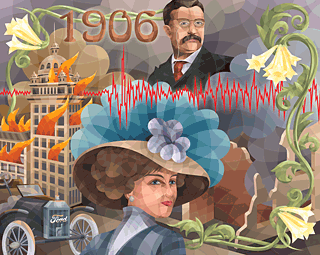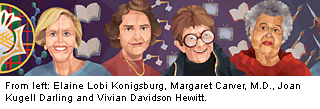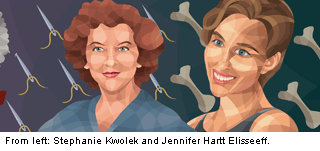Celebrating 100 Years of Carnegie Mellon Women
Celebrating 100 Years of Carnegie Mellon Women
The year is 1906. Theodore Roosevelt is President. A great earthquake destroys San Francisco. A new Ford costs $600. And, in Pittsburgh, 224 women enroll in the Carnegie Technical Schools’ new Margaret Morrison Carnegie School for Women.

In retrospect, the era seems quaint. “Bifurcate garments” (slacks!) were forbidden, and too-thin girls were required to drink a glass of milk each morning. But the studies were rigorous: minds were challenged, and knowledge and opinions developed.
Jump ahead 100 years—and thousands of women. The “Maggie Murphs” and their sister alumnae achieved, and continue to achieve, remarkable things. In their communities and their workplaces, from the hush of a library to the roar of a combat jet, these women have had a dramatic effect on daily life.
There are, of course, too many accomplished alumnae to note all of them. The women briefly profiled here represent all their sisters whose hearts, like Andrew Carnegie’s, are “in the work”—and whose work has high impact.
RIGHT BRAIN, LEFT BRAIN

From chemistry to best-selling children’s books
Researchers say that most people favor one side of their brains—either the logical left or the creative right. Elaine Lobl Konigsburg is an exception. She is a scientist-turned-author, with nearly two-dozen children’s books to her credit.
A 1952 Margaret Morrison chemistry major, she says that at Carnegie Tech “I learned the discipline of shaping ideas into a form that communicates them to others.” (She also, of course, learned chemistry, but that didn’t prevent her from blowing up a chem lab sink—twice—during graduate work at the University of Pittsburgh.)
While teaching chemistry at a private girls’ school, she discovered that she was “more interested in what was going on inside my students than inside the test tubes.” That interest grew even stronger as she raised her own three children—and when the youngest was in kindergarten, she began to write.
Konigsburg’s books fly off the shelves. “From the Mixed-Up Files of Mrs. Basil E. Frankweiler,” “The View From Saturday,” and her other works challenge and delight young readers with timeless plots, believable characters, and authentic settings. They also win awards—plenty of them; she’s the only author ever to have won the American Library Association’s prestigious Newbery Medal and its second-place “honor book” designation in the same year.
Accepting a 1999 Carnegie Mellon Alumni Distinguished Achievement Award, Konigsburg said: “The only course in writing I have ever had was Freshman Composition, taught by Dr. A. Fred Sochatoff. One of my books is dedicated to him. It says: For Fred Sochatoff —who was there at the beginning, before either of us knew it was a beginning.”
Today, Konigsburg lives near Jacksonville, Fl; she is working on a book to be published next year. She dismisses the notion of a “great divide” between left and right brains, saying “The quality of creativity is the same in the sciences as it is in the arts; it just curves left instead of right.”
Does she have advice for novice writers? Absolutely: “FINISH. That says a lot. It says that the difference between being a person with talent and being a writer is the ability to apply the seat of your pants to the seat of your chair—and finish. It says that even when the next word, the next thought won’t seem to come, you stay until it does.”
Related Links:
Meet the Author
Biographical Essay
E.L. Konigsburg Titles
SPECIAL DELIVERIES
Life as a small-town OB-GYN
Picture New York’s Carnegie Hall filled to the rafters with an applauding audience. Now picture it again. And again. That’s about 10,000 people—and that’s how many babies Margaret Carver, M.D. (MM ’43) delivered in her career as an obstetrician-gynecologist.
After attending medical school in the late 1940s, where she was one of only seven women in a class of 87, Carver interned in Harrisburg for the princely sum of $100 per month, plus six white uniforms. Then she opened a general practice in Uniontown, Pa., where her patients included women who hadn’t seen a doctor in 20 years—when the last female physician had practiced there.
Dr. Carver loved delivering babies, and there was no OB-GYN in town, so she did a residency and became board-certified in that specialty. “I like obstetrics because it’s a happy specialty,” says Carver. “Everybody’s joyful when you bring a baby into the world. They are beautiful little creatures.”
During the decades of her practice, she saw other health care gaps—and responded. She was largely responsible for setting up the area’s first mental health clinic and first family planning clinic. “People just didn’t have access to these services, and they needed them,” she recalls.
Dr. Carver retired from practice in 1997. Today, her macular degeneration limits some activities, but not reading—a special Library of Congress program, through Pittsburgh’s Carnegie Library, provides an abundance of materials on tape. She walks across the street from her home—still in Uniontown—to volunteer in the professional library of the hospital, where she also serves on the board. And she can’t go anywhere in the county without one of her moms, dads, or babies—many of them grown up with babies of their own—greeting her warmly.
Dr. Carver is frank about the changes she’s seen in American medicine: “I loved what I did, but the practice of medicine isn’t what it used to be,” she says. “Insurance companies have intruded into the doctor-patient relationship and have changed that relationship—for the worse. I understand why many doctors are giving up obstetrics, but it’s a shame.”
Related Link:
Dr. Margaret Carver M.D.
HACKMAN, REDFORD—AND CHUCKLES
Breaking the gender barrier in the control room
She’s done improv with Gene Hackman, taught at Robert Redford’s Sundance Institute, and directed what TV Guide called “the funniest episode ever on television.”
Joan Kugell Darling was a dramat at Carnegie Tech for three years in the mid-'50s before transferring to the University of Texas. She began acting, and then went to work for Mary Tyler Moore’s production company.
At a time when virtually no women directed television, she was unexpectedly asked to direct the famous “Chuckles Bites the Dust” episode of the Mary Tyler Moore Show because the regular director didn’t find humor in the script, which focuses on Mary’s uncontrollable laughter at the funeral of a clown. Darling found the humor, helped doubters in the cast and crew see the humanity in the episode, and supported Mary Tyler Moore as she created a legendary performance.
Darling won an Emmy for the episode and went on to a rich and varied career that has included another Emmy (for acting), a Director’s Guild Award, and multiple other honors.
“Success isn’t what I once thought it was,” Darling says. “It was great to have the guys at the studio gate know our names. But that doesn’t sustain you. The only things that last are the joy in the work, and the value in being an artist.”
Today, Darling and her husband, playwright Bill Svanoe, teach theater at the University of North Carolina at Chapel Hill. The schedule keeps them in touch with next-generation talent, and allows time to do workshops—including the Director’s Lab at Sundance—and to act, direct, and guest-lecture.
“I feel an enormous debt to Carnegie Tech,” she says. “I learned voice, speech, and movement. But the strongest thing I took away is an ethic about finding your heart and soul, about learning how to express what you want to express. That’s the joy in the work.”
Sometimes young actors and actresses ask Darling for advice. Here’s what she says: “Never, ever step up with anything less than your best. It doesn’t matter whether it’s a starring performance or a cold reading. Always do your utmost.”
Related Link:
Joan Kugell Darling
AN EYE FOR ART
Librarian builds superb collection
A collection of African-American art is drawing excellent reviews as it tours the country—and it exists because of the unerring eye of an alumna and her husband.
In 1944, after Vivian Hewitt (then Davidson) earned what would today be an M.L.S. degree from Carnegie Tech’s Library School, she became the first African-American librarian in Pittsburgh’s public library system. She later became the first African-American President of the Special Libraries Association, but she says, “I have never been comfortable with being the ‘first’ or ‘only.’ It brings great pressure: if I don’t succeed, others will be denied. As a nation, we won’t be where we need to be until there are no more ‘firsts’ or ‘onlys’ where race is concerned.”
In Pittsburgh, Atlanta, and then Manhattan, her career thrived, culminating in the position of chief librarian at the Carnegie Endowment for International Peace. In 1978, Hewitt received an honorary LHD degree from her undergraduate alma mater, Geneva College.
Along the way, Hewitt and her husband John, an editor of professional journals, traveled for business and pleasure. They visited galleries, studios, and salons, buying art they loved. Though their means were modest, their taste was impeccable, and during 50 years they built a collection that includes some of today’s best-known African-American artists—for example, Romare Bearden, Jacob Lawrence, and Carnegie Mellon alumna Ann Tanksley.
In 1998, the couple sold 58 pieces of their extensive collection to Bank of America, which decided that the works would tour the U.S. before being housed permanently at a new African-American Cultural Center in Charlotte, NC, where Bank of America is headquartered.
Hewitt, now 86 and widowed, still lives in Manhattan. She is a docent at the Cathedral of St. John the Divine, and she travels, reads—and does water aerobics. For this retired librarian, every day is a learning experience: “A day isn’t complete unless you’ve added some new information to your storehouse of knowledge,” she says. “You must keep learning.”
Hewitt is often asked how to begin buying art. Her response: “I tell people to buy where they live; every community has good artists, and you can get to know them and their work. So buy where you live—and, even more importantly, buy what you love.”
Related Links:
Hewitt Collection
The History Makers
BULLETPROOF

Even Alex Trebek knows her name
At different points in her life, Stephanie Kwolek wanted to be a fashion designer and a doctor. Ultimately, her career had elements of both: she invented a fiber used in clothing that saves lives.
A 1946 Margaret Morrison chemistry major, Kwolek went to work for DuPont. One day in 1965 she was dissolving a polymer, patiently trying solvent after solvent. Nothing worked—so she tried a solvent not normally used. It produced a thin, cloudy liquid that behaved differently from any other;when Kwolek tried to shake it off the spatula, it held together.
She had to work hard to persuade her male colleagues to run the liquid through a spinneret, a device that forces dissolved polymers through tiny holes, extruding stringlike fibers. To everyone’s surprise, the fiber from Kwolek’s liquid couldn’t be broken. This was something altogether new—and astonishingly strong.
A DuPont team developed the new fiber into Kevlar, which of course is the fabric used in bulletproof vests. Kwolek smiles as she recalls being at the White House in 1996 to receive the National Medal of Technology: she was treated indifferently by security forces until someone recognized her name. Suddenly, she was surrounded by guards and police clamoring to tell her how her invention had kept them safe.
Kwolek believes that Kevlar probably couldn’t even be invented today, because corporate America focuses more on near-term profits than on longer-term outcomes. “Productive research requires an investment of time and money,” she says. “It’s not like inventing a gadget in your garage.”
Today, Kevlar has more than 200 applications, and Stephanie Kwolek’s name appears on 17 patents. She has received innumerable awards and honors, and has even been an answer to a question on the popular game show Jeopardy. Retired since 1986, she spends much of her time working with professional associations and responding to mail from current and future scientists.
Related Links:
Chemical Achievers
The Great Idea Finder
Innovative Lives
Meet Stephanie Kwolek
POSITIONED TO CONQUER ARTHRITIS
Work could revolutionize treatment
The work of one Carnegie Mellon alumna may soon help reverse or even prevent the crippling effects of osteoarthritis.
Jennifer Hartt Elisseeff, a 1994 Mellon College of Science chemistry major, is an assistant professor of biomedical engineering and orthopedic surgery at Johns Hopkins University. Her pioneering work there involves developing materials for regenerative medicine—replacements or supplements for the human body’s own tissues.
One project involves a method of replacing cartilage, the tough elastic-like substance that is eroded in arthritic joints, leaving bones to grind painfully against each other. (Cartilage doesn’t regenerate naturally.) Elisseeff injects a stem cell-filled liquid polymer into the damaged area and then solidifies the gel, which acts as a “bio-scaffold” in which the stem cells multiply and produce new cartilage. One day patients may be able to donate their own stem cells for the procedure.
Elisseeff’s own company, Cartilix, is working on something for the nearer term: using biomaterials to promote healthy new cartilage. “The goal is to treat cartilage loss early to prevent progression to arthritis,” she says. The work draws acclaim and attention. For example, “Technology Review” named Elisseeff one of the country’s top innovators under age 35.
One of Elisseeff’s long-term goals is to become involved in science policy. She explains why: “The U.S. has had a unique leadership role in translating science because basic research has provided the ability to innovate, to produce new ideas that bring practical benefits. But basic research is a major investment, and it seems we’re not making enough of that investment these days. We may not see the consequences in the near term, but we will in the longer term. This is a science policy issue.”
Despite a daunting schedule, Elisseeff makes time to encourage young people toward careers in science and engineering. She says, “These are viable and exciting careers, but people still have the stereotypical image of the scientist working alone in the corner of a room. We scientists and engineers need to come out more and talk about our work and our lives.”



